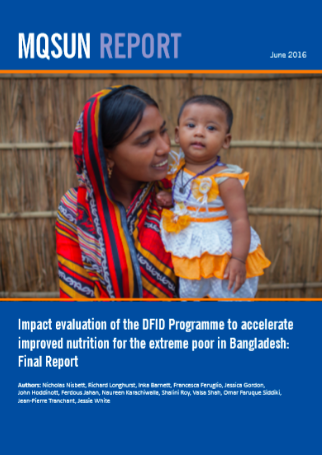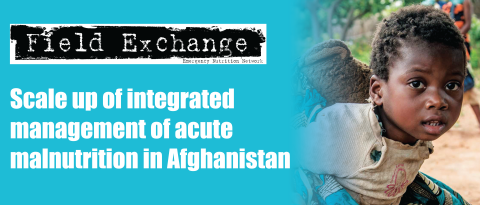Impact evaluation of a DFID programme to accelerate improved nutrition for the extreme poor in Bangladesh
Summary of evaluation1
Location: Bangladesh
What we know: There is little evidence of the impact of integrated livelihoods and nutrition programmes.
What this article adds: An evaluation measured the nutrition impact of adding a nutrition-specific intervention, focusing on infant and young child feeding (IYCF) behaviour change communication (BCC); micronutrient supplementation; and deworming via community nutrition workers (CNWs), into three existing livelihoods programmes among the extreme poor in Bangladesh (2013-2015). Quantitative and qualitative baseline and endline data were used to compare livelihoods plus nutrition (L+N) and livelihoods-only (L) interventions. There was limited impact of L+N on mother/caregiver knowledge of and attitudes towards IYCF, but large and significant positive change in knowledge of and attitudes towards iron consumption and supplementation. There were no significant impacts on breastfeeding practices, child dietary diversity, meal frequency or consumption of food from animal sources, but some significant positive impact on complementary feeding practices and significant positive change in consumption of iron-rich and iron-fortified foods. No impact was found on child nutritional status (measured by height-for-age z-score and weight-for-height z-score). Impact may be improved in future through greater intensity and adaptability of CNW counselling (focusing on context-specific problem solving), multiple channels of BCC and empowerment of mothers to have greater control over their time and practices.
Background
Although child undernutrition in Bangladesh has fallen over the last two decades, its prevalence remains high, affecting around one third of infants aged two and under, with the highest burden in extremely poor households concentrated in remote and climate-vulnerable parts of the country. Sub-optimal infant and young child feeding practices (IYCF) have been identified as a key driver for undernutrition in this age group. The UK Department for International Development (DFID) aimed to improve nutrition outcomes for young children, pregnant and lactating women (PLW) and adolescent girls through the integration of nutrition-specific interventions into three existing livelihoods programmes for extremely poor households in Bangladesh (described in Box 1). There is currently little research that directly assesses the impact of integrated livelihoods and nutrition programmes compared to livelihoods support alone. To help fill this gap, DFID commissioned a mixed-method evaluation to assess the impact of all three integrated programmes on nutritional status.
Box 1: Description of the three DFID-supported livelihoods programmes
Chars2 Livelihood Programme (CLP) aims to improve the livelihoods and food security of extremely poor and vulnerable char dwellers through infrastructure improvement, transfer of productive assets (cows and goats) and short-term social protection (cash stipends). The CLP delivered assets to approximately 312,000 people between 2010 and 2016.
Economic Empowerment of the Poorest (EEP) Concern supports one million extremely poor people in rural and urban areas via non-governmental organisations (NGOs) through input support and technology transfer for livelihoods (including guidance on cropping, livestock, fishing, bamboo working, small business and tailoring); capacity-building (through self-help groups, community-based organisations (CBOs) and links with local government); support for innovation; and links to markets and/or value chains.
Urban Partnership for Poverty Reduction (UPPR) aims to improve the livelihoods of three million extremely poor people living in urban areas through creation of community development committees (CDCs), which then propose their choice of livelihood support from a package of interventions (such as habitat and settlement improvement, improving incomes and assets, support for urban food production, small business management, support for education, community banking and enhancing social development and protection).
All three programmes introduced a set of complementary, nutrition-specific interventions from 2013 to 2015 targeting all PLW, adolescent girls and children under five years of age. Components delivered via community nutrition workers (CNWs) were behaviour change communication (BCC) during monthly household visits and community-level discussions; micronutrient supplementation (micronutrient powders for children aged 7-23 months and iron and folic acid (IFA) supplements for PLW and adolescent girls); and deworming (for children age 12 to 60 months and adolescent girls).

Methods
The evaluation used quantitative and qualitative methods to assess the impact of the combined nutrition-specific and livelihoods interventions (L+N) across the three programmes on knowledge and practices of mothers and caregivers and the nutritional status of children under two years old, compared to existing livelihoods interventions with no nutrition component (L only) (describing the nutrition intervention as ‘N’ and no intervention as ‘control’). The quantitative evaluation was undertaken at baseline (2013) and endline (2015) and qualitative evaluations were carried out at the beginning of 2014 and end of 2015.
Results
Mother’s knowledge and attitudes and IYCF
The impact of L+N on caregiver IYCF knowledge and attitude was limited, except for iron, where there was a large and highly statistically significant positive change in knowledge of and attitudes to iron consumption and iron supplementation (about 8-9 percentage point increases in CLP and EEP Concern). Regarding appropriate breastfeeding and complementary feeding practices, there was modest scope for improvement since maternal knowledge was already relatively high for both groups at the outset. There was a lack of awareness of the dangers of not following recommended practices and the importance of following optimal IYCF practices in special circumstances (such as after a caesarean section).
Nutrition practices
There were no significant impacts on breastfeeding practices in any of the three programmes, although in UPPR there were borderline significant positive effects on exclusive breastfeeding and predominant breastfeeding. In EEP Concern, where introduction of water and other liquids before the age of six months was most common, adding the N interventions caused a significant reduction in these practices (reducing giving water and other liquids to infants under six months old by 11 percentage points and 12 percentage points respectively).
L+N resulted in significant positive behaviour change in iron intake; across the CLP and UPPR programmes there were significant increases in the consumption of iron-rich and iron-fortified foods (13 percentage points and 12 percentage points respectively) and a borderline significant increase of 12 percentage points in EEP Concern.
None of the programmes had significant impacts on dietary diversity (DD) of the child, meal frequency, or consumption of food from animal sources.
Barriers to behaviour change included lack of financial resources, lack of time to prepare recommended foods, fear of food wastage, household taste and wider social food preferences, limited influence of mothers on household decision-making, and deeply rooted, context-specific IYCF beliefs. In terms of women’s status, results showed that the nutrition component did not have an additional impact on women’s involvement in spending decisions within the household over and above the livelihoods component (discussed below). However, qualitative data suggests that including mothers-in-law (the main decision-makers in child feeding and food choices) in nutrition counselling may have had some positive impact on decisions made about child feeding care practices.
Overall, results suggest that investing more in the CNWs does have the potential to achieve greater improvements in certain individual behaviours. However, practices only changed when there was no requirement for significant investment of new time or resources by mothers and other caregivers.
Child nutritional status
The core measure of child nutritional status used was height-for-age z-score (HAZ), on the assumption that large changes in IYCF practices over a prolonged period or in a mother’s diet during pregnancy could reduce levels of stunting. This was an ambitious goal over a two-year period. The endline survey included children aged 6-24 months, all of whom would have been exposed to the N interventions throughout their critical first 1,000 days (including prenatally for most). Results showed no significant impact on HAZ, weight-for-height z-score (WHZ), stunting prevalence or wasting prevalence. It is not known if mother’s knowledge and use of iron supplements had any impact on child iron status, as this was not measured. This may be explained by the infrequent contact with CNWs, with little time during visits to discuss important nutrition messages, particularly for complementary feeding.
Given the importance of complementary feeding and the inclusion of animal-source foods in the diet for linear growth, it is not surprising that there were no significant impacts on anthropometry via this pathway. There was also limited evidence for alternative potential pathways for anthropometry impacts via, for example, reductions in open defecation.
Awareness of undernutrition improved among beneficiaries in the L+N programmes, with people being more conscious of the signs and ill effects of undernutrition; however, undernutrition was still perceived as ‘normal’ and preventing and addressing it did not become a priority for poor households.
Impact of the livelihoods interventions
Only qualitative data were available for CLP and EEP Concern programmes due to a lack of appropriate control groups. The overall perceived benefits of participating in these two programmes (L versus no intervention) were substantial, although perceived direct economic benefits were relatively small in some cases. Additional income was used to improve overall living standards and pay off debts. In the UPPR programme it was difficult to attribute changes to the programme itself, as households also received a wide range of benefits from other NGOs. Some UPPR-beneficiary households described how they used programme support to transform their assets, diversify their income and improve their overall economic wellbeing. Others used UPPR grants to start a business or renovate their house but did not report experiencing any long-term economic improvements.
Quantitative results in the UPPR programme showed no significant impacts on either household DD or mothers’ BMI in either L or L+N. There were also no meaningful impacts on practices related to breastfeeding or the introduction of other liquids and solids and the L components alone had no impact on complementary feeding. On access to sanitary latrines, there were no statistically significant impacts from either L or L+N. In terms of women’s status, there was no significant impact from L-only or L+N on the proportion of mothers reporting that they participate either solely or jointly in decision-making on household expenditure (including on food and health), and no significant impact on the proportion of mothers reporting that they now controlled funds needed to purchase items themselves. There was, however, a small but statistically significant increase in women having a voice in decisions regarding where they could go alone. There were no significant impacts on anthropometric outcomes from L or L+N interventions. In the UPPR programme it appears that L+N households could not readily act on the advice they had been given by CNWs, because they did not have the funds or resources to do so.
Conclusion and recommendations
Results of the evaluation are sobering due to the lack of improvement in child anthropometry and the sparse improvements in IYCF knowledge and practices. However, the results give a clear picture of the barriers and enablers to successful progress along the impact pathway, which may inform future design and implementation.
The authors recommend greater intensity and adaptability of CNW practice to deliver real change (including a focus on context-appropriate problem solving), multiple channels of BCC and, to ensure that the most beneficial IYCF practices are adopted, a revised L+N intervention that simultaneously delivers this improved BCC, alongside measures to empower mothers (including greater control over their time and practices and changes in wider community norms and beliefs around IYCF and mothers’ control).
Endnotes
1Nisbett N, Longhurst R, Barnett I, Feruglio F, Gordon J, Hoddinott J et al. (2016) MQSUN Report: Impact evaluation of the DFID Programme to accelerate improved nutrition for the extreme poor in Bangladesh: Final Report.
2“Chars”, which are home to over five million people in Bangladesh, are riverine sand and silt landmasses that are highly vulnerable to sudden and forceful flooding as well as erosion and loss of land, which makes living in them hazardous and insecure.


